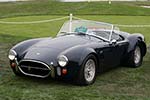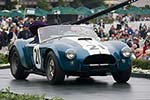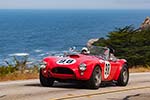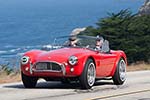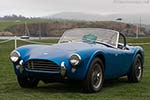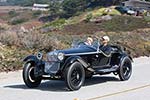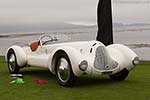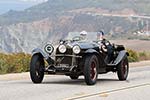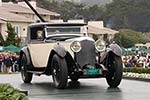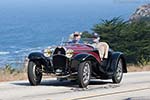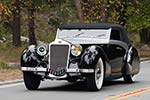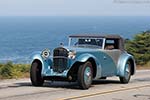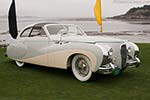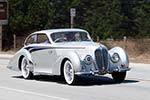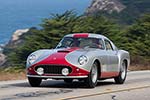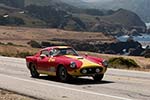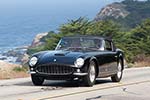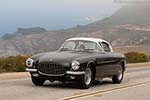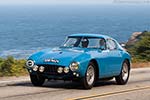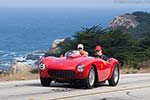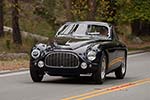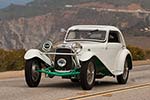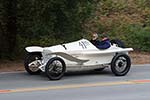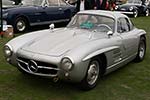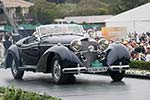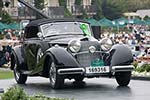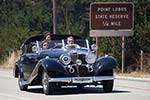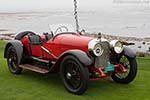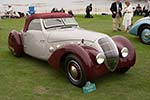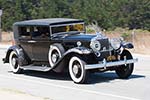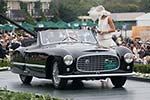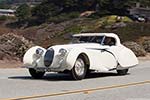Introduction

Every third Sunday in August, the Pebble Beach Lodge opens its meticulously prepared 18th fairway to over 200 of the world's finest classic cars and motorcycles. The annual 'Concours d'Elegance' is the traditional climax of a complete week of shows, races and auctions held on the Monterey Peninsula. In addition to the familiar classes, the 62nd edition featured special classes for the cars of the Maharajas, coachwork by Saoutchik, Mercer, Fiat and the 50th anniversary of the Shelby Cobra. The passing of Sergio Pininfarina was also commemorated with a special appearance of the very first Ferrari bodied by the legendary coachbuilder. This 212 Inter Cabriolet was restored by Pininfarina during the 1980s following direct instructions from the late Sergio Pininfarina. Prominent collector of very early Grand Prix cars, George Wingard received the Lorin Tryon Trophy for his contributions to the Pebble Beach Concours d'Elegance.
Our photographers were at Pebble Beach from the creek of dawn to see the first cars enter the field until the last entrants left again twelve hours later. The result is this spectacular
310-shot gallery. It is complemented by a
70-shot gallery of the Tour d'Elegance, which includes many of the entrants in action.
Tour d'Elegance

Traditionally headed by Sir Stirling and Lady Susie Moss in a Mercedes-Benz 300 SL, the Tour d'Elegance is one of our favourite events of the week. All the entrants of the Concours d'Elegance are invited to take part, and although participating is not mandatory, successfully completing the Tour will give entrants an edge in case of a tie during the Concours. This year the route was unchanged and led the entrants from the Pebble Beach Lodge over 17-Mile Drive to the Tehema estate and subsequently down Highway 1 to the turn around point at Big Sur. Another set fixture is the lunch-break on Ocean Avenue in Carmel before returning to Pebble Beach in the afternoon. The traditional fog burned off sooner than normal, offering participants a clearer view on Highway 1, which ranks as one of the most beautiful roads in the United States. This also allowed us to capture the cars with beautiful backdrops as can be seen in our
70-shot gallery of the Tour d'Elegance.
The cars of the Maharajas

Indian royals, or Maharajas, ordered some of the most extravagant cars of the 1920s and 1930s. These were not only used for state affairs but also for other activities like hunting and racing. Rolls-Royce was the manufacturer of choice for the Maharajas with body-styles ranging from luxurious limousines to more spartan roadsters built for hunting. Accordingly, the special class for the Maharaja cars was split in two with one dedicated to Rolls-Royces. Literally one of the stars in the Rolls-Royce class was the Phantom II clothed by Thrupp & Maberly, which is better known as the 'Star of India'. Like many of the Maharajas' vehicles, it had left India during the 1960s but at a recent auction was bought back by the grandson of the original owner as a 75th birthday present for his father. Making the most waves, no pun intended, of all the Maharaja cars was Evert Louwman's Brooke Swan Car. It features a unique swan shaped body, sculpted entirely from wood. The Maharaja of Nadjab also commissioned a smaller sized 'cygnet' for use on his estate. This remains as the first ever car built in India.
Coachwork by Saoutchik

Born as Iakov Saoutchik in Minsk, Jacques Saoutchik left his homeland for Paris in 1898. Although he was just 18 years old, he was already a skilled cabinet maker. Soon after arriving in the 'City of Light', he switched his focus to clothing cars and established his own coach-building company. Compared to his rivals, Saoutchik's designs often stood out for extravagance and flamboyance. After World War II, he pushed the envelope even further. Like so many of the company's rivals, Saoutchik suffered from dwindling sales and eventually ceased trading in 1955. This year's dedicated class beautifully illustrated the evolution of Jacques Saoutchik's designs. His earliest creations present were two of the seven Torpedos built on the powerful Mercedes-Benz 680 S chassis. Dating from his most extravagant period were a purple Cadillac and a Delahaye 175 complete with 14-karat gold interior trim. Saoutchik also developed a parallel opening door system, which used pantograph linkages. This was used by both the striking Hispano Suiza 'Xenia' built for Andre Dubonnet and the slightly more understated Delage D8-120 S used by President Charles de Gaulle after the War.
Shelby Cobra

The 50th anniversary of one of America's greatest sports cars, the Shelby Cobra, was also celebrated at Pebble Beach. After the sad passing of Carroll Shelby earlier this year, the celebrations did get a slightly different character, doubling as a tribute to the Cobra's legendary creator. To mark the occasion, many of the most significant Cobras lined up at the far end of the 18th fairway. Among them were the very first and the last ever example produced. Also present was one of the five open Cobras built to compete in the 1964 World Championship, alongside the new Daytona Coupes. It is one of the two surviving examples and the only works Cobra that is still in original condition. It even sports the same tyres as it wore during its final race, in 1965. Another important Shelby team car present was the first ever '427' built. This was the only big block-engined Cobra raced by the works squad and saw use in the USRRC and SCCA championships. Fittingly, the Cobra class was complemented by a class for the AC Ace from which the Cobra had originally been derived.
Further highlights

As always, the Pebble Beach Concours d'Elegance entry consisted of a colourful mix of the beautiful, the unusual, the interesting or more often than not a combination of these. Ticking the first and third boxes was the Jaguar XK120 Roadster on the field. It was the first left-hand drive example and was first owned by Hollywood legend Clark Gable. In the Ferrari category many eyes were on the Ferrari 375 Plus, fitted with a unique Pinin Farina Cabriolet body. This was the second Ferrari built specifically for King Leopold from Belgium and had not been seen in public for almost two decades. Certainly unusual was the mid-engined unique Hoffman X-8 Sedan built in 1935. The X-8 was a reference to the engine, which was constructed from two narrow-angle V4s bolted together in an X configuration. Also a mid-engined American one-off was the Norman Timbs Roadster of a slightly later vintage. Crafted by Emil Diedt, the car sports a one-piece rear body-section that is an absolute work of art.
Best of show

The 62nd Pebble Beach Concours d'Elegance was concluded with the award ceremony of the all-important 'best of show'. This is picked from the class winners by the board of Honorary Judges that consisted of the likes of racing legend Sir Stirling Moss, automotive designer Fabrizio Giugiaro but also game developer Shiro Nakamura. They bestowed the great honour on the Mercedes-Benz 680 S Saoutchik Torpedo brought by Paul & Judy Andrews. As mentioned earlier, Saoutchik built seven of these bodies, each differing in detail. This example was shown at the 1928 New York Auto Show and soon after acquired by Frederick Henry Bedford. His family held on to the car until 2006 when it was offered at auction. It has since passed through various hands before it entered the current owner's collection. He entrusted the car to marque expert Paul Russell for a complete restoration. The result is absolutely staggering and the Saoutchik Torpedo is more than a deserved best of show winner.
Final thoughts
Another edition has been added to the Pebble Beach Concours d'Elegance's already very rich history book. This year's show featured a particularly varied entry, helped by the diverse themes. At the end of the award ceremonies the first of next year's themes was already announced; Lincoln. But lets not get ahead of ourselves and first enjoy the 62nd edition by exploring our
Concours d'Elegance and
Tour d'Elegance galleries consisting of a combined total of close to 400 shots.

 Every third Sunday in August, the Pebble Beach Lodge opens its meticulously prepared 18th fairway to over 200 of the world's finest classic cars and motorcycles. The annual 'Concours d'Elegance' is the traditional climax of a complete week of shows, races and auctions held on the Monterey Peninsula. In addition to the familiar classes, the 62nd edition featured special classes for the cars of the Maharajas, coachwork by Saoutchik, Mercer, Fiat and the 50th anniversary of the Shelby Cobra. The passing of Sergio Pininfarina was also commemorated with a special appearance of the very first Ferrari bodied by the legendary coachbuilder. This 212 Inter Cabriolet was restored by Pininfarina during the 1980s following direct instructions from the late Sergio Pininfarina. Prominent collector of very early Grand Prix cars, George Wingard received the Lorin Tryon Trophy for his contributions to the Pebble Beach Concours d'Elegance.
Every third Sunday in August, the Pebble Beach Lodge opens its meticulously prepared 18th fairway to over 200 of the world's finest classic cars and motorcycles. The annual 'Concours d'Elegance' is the traditional climax of a complete week of shows, races and auctions held on the Monterey Peninsula. In addition to the familiar classes, the 62nd edition featured special classes for the cars of the Maharajas, coachwork by Saoutchik, Mercer, Fiat and the 50th anniversary of the Shelby Cobra. The passing of Sergio Pininfarina was also commemorated with a special appearance of the very first Ferrari bodied by the legendary coachbuilder. This 212 Inter Cabriolet was restored by Pininfarina during the 1980s following direct instructions from the late Sergio Pininfarina. Prominent collector of very early Grand Prix cars, George Wingard received the Lorin Tryon Trophy for his contributions to the Pebble Beach Concours d'Elegance. Traditionally headed by Sir Stirling and Lady Susie Moss in a Mercedes-Benz 300 SL, the Tour d'Elegance is one of our favourite events of the week. All the entrants of the Concours d'Elegance are invited to take part, and although participating is not mandatory, successfully completing the Tour will give entrants an edge in case of a tie during the Concours. This year the route was unchanged and led the entrants from the Pebble Beach Lodge over 17-Mile Drive to the Tehema estate and subsequently down Highway 1 to the turn around point at Big Sur. Another set fixture is the lunch-break on Ocean Avenue in Carmel before returning to Pebble Beach in the afternoon. The traditional fog burned off sooner than normal, offering participants a clearer view on Highway 1, which ranks as one of the most beautiful roads in the United States. This also allowed us to capture the cars with beautiful backdrops as can be seen in our 70-shot gallery of the Tour d'Elegance.
Traditionally headed by Sir Stirling and Lady Susie Moss in a Mercedes-Benz 300 SL, the Tour d'Elegance is one of our favourite events of the week. All the entrants of the Concours d'Elegance are invited to take part, and although participating is not mandatory, successfully completing the Tour will give entrants an edge in case of a tie during the Concours. This year the route was unchanged and led the entrants from the Pebble Beach Lodge over 17-Mile Drive to the Tehema estate and subsequently down Highway 1 to the turn around point at Big Sur. Another set fixture is the lunch-break on Ocean Avenue in Carmel before returning to Pebble Beach in the afternoon. The traditional fog burned off sooner than normal, offering participants a clearer view on Highway 1, which ranks as one of the most beautiful roads in the United States. This also allowed us to capture the cars with beautiful backdrops as can be seen in our 70-shot gallery of the Tour d'Elegance. Indian royals, or Maharajas, ordered some of the most extravagant cars of the 1920s and 1930s. These were not only used for state affairs but also for other activities like hunting and racing. Rolls-Royce was the manufacturer of choice for the Maharajas with body-styles ranging from luxurious limousines to more spartan roadsters built for hunting. Accordingly, the special class for the Maharaja cars was split in two with one dedicated to Rolls-Royces. Literally one of the stars in the Rolls-Royce class was the Phantom II clothed by Thrupp & Maberly, which is better known as the 'Star of India'. Like many of the Maharajas' vehicles, it had left India during the 1960s but at a recent auction was bought back by the grandson of the original owner as a 75th birthday present for his father. Making the most waves, no pun intended, of all the Maharaja cars was Evert Louwman's Brooke Swan Car. It features a unique swan shaped body, sculpted entirely from wood. The Maharaja of Nadjab also commissioned a smaller sized 'cygnet' for use on his estate. This remains as the first ever car built in India.
Indian royals, or Maharajas, ordered some of the most extravagant cars of the 1920s and 1930s. These were not only used for state affairs but also for other activities like hunting and racing. Rolls-Royce was the manufacturer of choice for the Maharajas with body-styles ranging from luxurious limousines to more spartan roadsters built for hunting. Accordingly, the special class for the Maharaja cars was split in two with one dedicated to Rolls-Royces. Literally one of the stars in the Rolls-Royce class was the Phantom II clothed by Thrupp & Maberly, which is better known as the 'Star of India'. Like many of the Maharajas' vehicles, it had left India during the 1960s but at a recent auction was bought back by the grandson of the original owner as a 75th birthday present for his father. Making the most waves, no pun intended, of all the Maharaja cars was Evert Louwman's Brooke Swan Car. It features a unique swan shaped body, sculpted entirely from wood. The Maharaja of Nadjab also commissioned a smaller sized 'cygnet' for use on his estate. This remains as the first ever car built in India. Born as Iakov Saoutchik in Minsk, Jacques Saoutchik left his homeland for Paris in 1898. Although he was just 18 years old, he was already a skilled cabinet maker. Soon after arriving in the 'City of Light', he switched his focus to clothing cars and established his own coach-building company. Compared to his rivals, Saoutchik's designs often stood out for extravagance and flamboyance. After World War II, he pushed the envelope even further. Like so many of the company's rivals, Saoutchik suffered from dwindling sales and eventually ceased trading in 1955. This year's dedicated class beautifully illustrated the evolution of Jacques Saoutchik's designs. His earliest creations present were two of the seven Torpedos built on the powerful Mercedes-Benz 680 S chassis. Dating from his most extravagant period were a purple Cadillac and a Delahaye 175 complete with 14-karat gold interior trim. Saoutchik also developed a parallel opening door system, which used pantograph linkages. This was used by both the striking Hispano Suiza 'Xenia' built for Andre Dubonnet and the slightly more understated Delage D8-120 S used by President Charles de Gaulle after the War.
Born as Iakov Saoutchik in Minsk, Jacques Saoutchik left his homeland for Paris in 1898. Although he was just 18 years old, he was already a skilled cabinet maker. Soon after arriving in the 'City of Light', he switched his focus to clothing cars and established his own coach-building company. Compared to his rivals, Saoutchik's designs often stood out for extravagance and flamboyance. After World War II, he pushed the envelope even further. Like so many of the company's rivals, Saoutchik suffered from dwindling sales and eventually ceased trading in 1955. This year's dedicated class beautifully illustrated the evolution of Jacques Saoutchik's designs. His earliest creations present were two of the seven Torpedos built on the powerful Mercedes-Benz 680 S chassis. Dating from his most extravagant period were a purple Cadillac and a Delahaye 175 complete with 14-karat gold interior trim. Saoutchik also developed a parallel opening door system, which used pantograph linkages. This was used by both the striking Hispano Suiza 'Xenia' built for Andre Dubonnet and the slightly more understated Delage D8-120 S used by President Charles de Gaulle after the War. The 50th anniversary of one of America's greatest sports cars, the Shelby Cobra, was also celebrated at Pebble Beach. After the sad passing of Carroll Shelby earlier this year, the celebrations did get a slightly different character, doubling as a tribute to the Cobra's legendary creator. To mark the occasion, many of the most significant Cobras lined up at the far end of the 18th fairway. Among them were the very first and the last ever example produced. Also present was one of the five open Cobras built to compete in the 1964 World Championship, alongside the new Daytona Coupes. It is one of the two surviving examples and the only works Cobra that is still in original condition. It even sports the same tyres as it wore during its final race, in 1965. Another important Shelby team car present was the first ever '427' built. This was the only big block-engined Cobra raced by the works squad and saw use in the USRRC and SCCA championships. Fittingly, the Cobra class was complemented by a class for the AC Ace from which the Cobra had originally been derived.
The 50th anniversary of one of America's greatest sports cars, the Shelby Cobra, was also celebrated at Pebble Beach. After the sad passing of Carroll Shelby earlier this year, the celebrations did get a slightly different character, doubling as a tribute to the Cobra's legendary creator. To mark the occasion, many of the most significant Cobras lined up at the far end of the 18th fairway. Among them were the very first and the last ever example produced. Also present was one of the five open Cobras built to compete in the 1964 World Championship, alongside the new Daytona Coupes. It is one of the two surviving examples and the only works Cobra that is still in original condition. It even sports the same tyres as it wore during its final race, in 1965. Another important Shelby team car present was the first ever '427' built. This was the only big block-engined Cobra raced by the works squad and saw use in the USRRC and SCCA championships. Fittingly, the Cobra class was complemented by a class for the AC Ace from which the Cobra had originally been derived. As always, the Pebble Beach Concours d'Elegance entry consisted of a colourful mix of the beautiful, the unusual, the interesting or more often than not a combination of these. Ticking the first and third boxes was the Jaguar XK120 Roadster on the field. It was the first left-hand drive example and was first owned by Hollywood legend Clark Gable. In the Ferrari category many eyes were on the Ferrari 375 Plus, fitted with a unique Pinin Farina Cabriolet body. This was the second Ferrari built specifically for King Leopold from Belgium and had not been seen in public for almost two decades. Certainly unusual was the mid-engined unique Hoffman X-8 Sedan built in 1935. The X-8 was a reference to the engine, which was constructed from two narrow-angle V4s bolted together in an X configuration. Also a mid-engined American one-off was the Norman Timbs Roadster of a slightly later vintage. Crafted by Emil Diedt, the car sports a one-piece rear body-section that is an absolute work of art.
As always, the Pebble Beach Concours d'Elegance entry consisted of a colourful mix of the beautiful, the unusual, the interesting or more often than not a combination of these. Ticking the first and third boxes was the Jaguar XK120 Roadster on the field. It was the first left-hand drive example and was first owned by Hollywood legend Clark Gable. In the Ferrari category many eyes were on the Ferrari 375 Plus, fitted with a unique Pinin Farina Cabriolet body. This was the second Ferrari built specifically for King Leopold from Belgium and had not been seen in public for almost two decades. Certainly unusual was the mid-engined unique Hoffman X-8 Sedan built in 1935. The X-8 was a reference to the engine, which was constructed from two narrow-angle V4s bolted together in an X configuration. Also a mid-engined American one-off was the Norman Timbs Roadster of a slightly later vintage. Crafted by Emil Diedt, the car sports a one-piece rear body-section that is an absolute work of art. The 62nd Pebble Beach Concours d'Elegance was concluded with the award ceremony of the all-important 'best of show'. This is picked from the class winners by the board of Honorary Judges that consisted of the likes of racing legend Sir Stirling Moss, automotive designer Fabrizio Giugiaro but also game developer Shiro Nakamura. They bestowed the great honour on the Mercedes-Benz 680 S Saoutchik Torpedo brought by Paul & Judy Andrews. As mentioned earlier, Saoutchik built seven of these bodies, each differing in detail. This example was shown at the 1928 New York Auto Show and soon after acquired by Frederick Henry Bedford. His family held on to the car until 2006 when it was offered at auction. It has since passed through various hands before it entered the current owner's collection. He entrusted the car to marque expert Paul Russell for a complete restoration. The result is absolutely staggering and the Saoutchik Torpedo is more than a deserved best of show winner.
The 62nd Pebble Beach Concours d'Elegance was concluded with the award ceremony of the all-important 'best of show'. This is picked from the class winners by the board of Honorary Judges that consisted of the likes of racing legend Sir Stirling Moss, automotive designer Fabrizio Giugiaro but also game developer Shiro Nakamura. They bestowed the great honour on the Mercedes-Benz 680 S Saoutchik Torpedo brought by Paul & Judy Andrews. As mentioned earlier, Saoutchik built seven of these bodies, each differing in detail. This example was shown at the 1928 New York Auto Show and soon after acquired by Frederick Henry Bedford. His family held on to the car until 2006 when it was offered at auction. It has since passed through various hands before it entered the current owner's collection. He entrusted the car to marque expert Paul Russell for a complete restoration. The result is absolutely staggering and the Saoutchik Torpedo is more than a deserved best of show winner.



